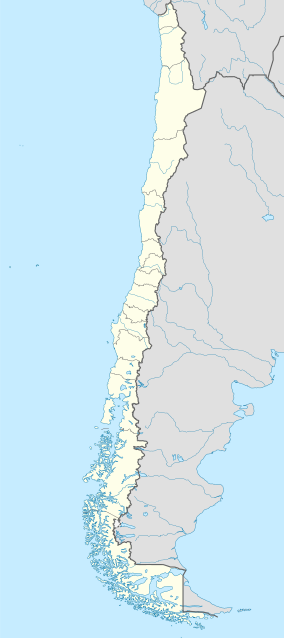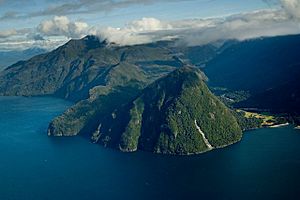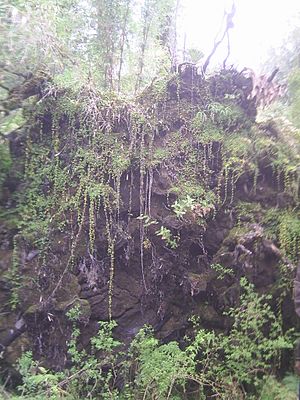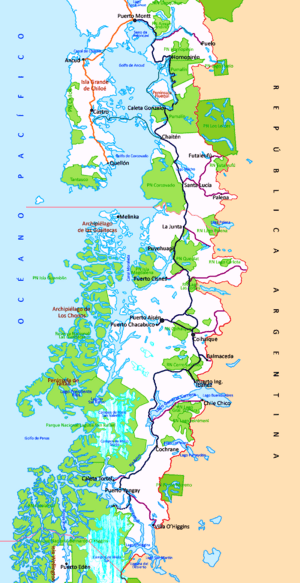Pumalín Douglas Tompkins National Park facts for kids
Quick facts for kids Pumalín Douglas Tompkins National Park |
|
|---|---|
|
IUCN Category II (National Park)
|
|

Lago Negro, Pumalín
|
|
| Location | Los Lagos Region, Chile |
| Nearest city | Hualaihué |
| Area | 994,331 acres (402,392 hectares) |
| Established | 2018 |
| Governing body | Corporación Nacional Forestal |
Pumalín Douglas Tompkins National Park (in Spanish: Parque nacional Pumalín Douglas Tompkins) is a huge national park in Chile. It covers about 400,000 hectares (almost 1 million acres) in the Palena Province. This amazing park was created by a group called Tompkins Conservation. It was started by an American businessman and nature lover named Doug Tompkins and his wife, Kris Tompkins.
Pumalín Park was first called a "Nature Sanctuary" in 2005. This meant it was a special protected area. It was Chile's biggest private nature reserve. The park had many trails, places to camp, and visitor centers for people to enjoy. In 2017, the park was given to the Chilean government. It officially became a national park in 2018.
Contents
How Pumalín Park Started
In 1991, Doug Tompkins bought a large piece of land in Chile. This land was in the Reñihue River Valley. Doug was a mountaineer and loved nature. He had visited Patagonia since the 1960s. He wanted to protect this land, which had a beautiful Valdivian temperate rainforest. He wanted to stop it from being used for things that would harm nature.
Doug and his wife, Kris Tompkins, moved to Reñihué. Doug then started planning a bigger park. He bought more land from people who wanted to sell. Most of the park's land (about 98%) was bought from owners who did not live there.
Tompkins Conservation (which was then called The Conservation Land Trust) added more land. This made Pumalín Park much bigger. On August 19, 2005, the park was named a Nature Sanctuary. This special name was given by Chile's president at the time, Ricardo Lagos. It gave the land extra protection to keep its natural beauty safe.
At first, some people in Chile were unsure about a private person buying so much land for a park. In the United States, people often donate land for parks. But in Chile, this was new. The park's land stretched from Argentina to the Pacific Ocean. Some officials worried it might cut the country in half. Some local people even thought the Tompkinses would remove farm animals or use the land for nuclear waste. But over time, as the park grew and welcomed many visitors, people began to trust the project.
Pumalín Park became a national park in 2018. This happened after Tompkins Conservation donated almost 725,000 acres of land. The new park was named Pumalín Douglas Tompkins National Park to honor its founder.
Amazing Plants and Animals
One of the main goals of Pumalín Park is to protect biodiversity. This means protecting all the different kinds of life in the area. The park offers a wonderful wilderness experience. It also keeps the area's special plants and animals safe.
Chile does not have as many different kinds of animals as places like the Amazon. But it has many unique plants. Many plant species grow only in Chile. The park has a special kind of forest called the Valdivian temperate rainforest. This forest has thousands of plant species. The coastal forests of Pumalín Park get a lot of rain, about 6,000 millimeters (236 inches) each year. These very wet, old forests reach all the way to the ocean. This is something that is becoming very rare in the world.
The park also protects some of the last remaining Alerce trees. These trees are some of the oldest living things on Earth. About 25% of all the remaining Alerce trees are protected inside Pumalín Park.
The Park and Local Life
The park has a system of rangers. These rangers help take care of the park. They also work on farms next to the protected areas. These small organic farms do things like raising animals, making cheese, and producing honey. They also offer ecotourism (tourism focused on nature) and sell handmade wool items. These farms act as park ranger stations and places where visitors can get information. This way, the park helps protect nature and also helps the local economy. The project works with people living near the park. It helps them understand how important it is to protect nature. It also shows how farming can help keep nature safe and create jobs.
El Amarillo Town
El Amarillo is a town at the southern entrance of the park. In 2007, the Tompkinses started a project to make the town more beautiful. Doug Tompkins believed that making the town look better would make local people proud. This pride would then spread across the country.
In 2008, a nearby volcano erupted and damaged much of the town. Tompkins Conservation took on a special project to rebuild the area. They renovated and built many beautiful new things. These included four farms, a tourism building, two churches, a market called Puma Verde, a community center, two supermarkets, and over two dozen houses. All these buildings were designed to match the old style of the area.
Visiting Pumalín Park
Pumalín is one of the most popular nature attractions in southern Chile. You can reach it by car or by boat. Caleta Gonzalo is in the middle of the park, in the Reñihué Fjord. It has the main visitor facilities. These include a restaurant, a visitor center, cabins (cabañas), and a campground. During the summer, ferries travel from the village of Hornopirén to Caleta Gonzalo.
After the Chaitén Volcano erupted in 2008, the park was closed for a while. It reopened to visitors in December 2010.
See also
 In Spanish: Parque nacional Pumalín para niños
In Spanish: Parque nacional Pumalín para niños





